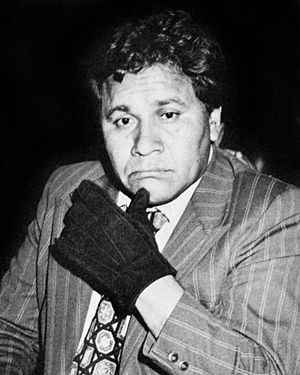Oscar Zeta Acosta facts for kids
Quick facts for kids
Oscar Zeta Acosta
|
|
|---|---|

|
|
| Born |
Oscar Acosta Fierro
April 8, 1935 |
| Disappeared | May 27, 1974 (aged 39) Mazatlán, Sinaloa, Mexico |
| Status | Missing for 51 years, 6 months and 23 days |
| Education | San Francisco State University (BA) San Francisco Law School (JD) |
| Occupation | Attorney, author, activist |
| Known for | Activism, friendship with Hunter S. Thompson |
|
Notable work
|
Autobiography of a Brown Buffalo The Revolt of the Cockroach People |
| Movement | Chicano Movement |
Oscar "Zeta" Acosta Fierro (born April 8, 1935) was a Mexican-American lawyer, writer, and activist. He was an important figure in the Chicano Movement, which worked for the rights of Mexican Americans.
Acosta is best known for his books Autobiography of a Brown Buffalo (1972) and The Revolt of the Cockroach People (1973). He was also a close friend of the famous American writer Hunter S. Thompson. Thompson wrote about Acosta as the character Dr. Gonzo in his 1971 novel Fear and Loathing in Las Vegas. Oscar Acosta disappeared in 1974 while traveling in Mexico and is believed to have died.
Contents
Early Life and Education
Oscar Acosta was born in El Paso, Texas, on April 8, 1935. His parents were Manuel and Juanita Acosta. His family later moved to California, where he grew up in a small town called Riverbank.
After high school, Acosta joined the United States Air Force. When he left the Air Force, he went to Modesto Junior College. He then attended San Francisco State University, where he studied creative writing. He was the first person in his family to go to college. Later, he studied law at San Francisco Law School at night and became a lawyer in 1966.
Becoming an Activist Lawyer
In 1967, Oscar Acosta started working as a lawyer helping people who were struggling with poverty in Oakland, California. In 1968, he moved to East Los Angeles and became a key lawyer for the Chicano Movement. This movement fought for the civil rights of Mexican Americans.
Acosta defended many Chicano groups and activists in court. He represented people involved in the East L.A. walkouts, members of the Brown Berets, and other community leaders. His strong defenses sometimes caused problems with the police.
In 1970, Acosta ran for sheriff of Los Angeles County. He received more than 100,000 votes, showing how much support he had.
His Books
Oscar Acosta wrote two important novels that shared his experiences and the struggles of the Chicano Movement.
In 1972, he published his first novel, Autobiography of a Brown Buffalo. This book is about a lawyer who fights for the rights of people who are often ignored.
In 1973, he published The Revolt of the Cockroach People. This novel tells a fictional story based on real events from the 1970 Chicano Moratorium. It also talks about the death of a journalist named Rubén Salazar.
Friendship with Hunter S. Thompson
Oscar Acosta met the writer Hunter S. Thompson in 1967. In 1971, Thompson wrote an article for Rolling Stone magazine about Acosta and the problems faced by people in East Los Angeles.
While working on this article, Thompson and Acosta decided to take a trip to Las Vegas, Nevada. They wanted to talk freely about their ideas away from any possible police attention. Thompson later wrote about this trip in his famous 1971 novel Fear and Loathing in Las Vegas. In the book, Thompson changed Acosta's character to a "300-pound Samoan" named Dr. Gonzo.
Acosta was at first upset that Thompson changed his race in the book. However, he agreed to let the book be published if his real name and picture were included on the book's cover.
Some scholars believe that Acosta greatly influenced Thompson's book. He may have even provided many of the ideas and events for the story. Acosta once told one of Thompson's editors, "Hunter has stolen my soul. He has taken my best lines and has used me." Even though their friendship became difficult, Thompson later wrote an article about Acosta after his disappearance.
Disappearance
In May 1974, Oscar Acosta disappeared while he was traveling in Mazatlán, Sinaloa, Mexico. His son, Marco Acosta, believes he was the last person to speak with his father.
In 1977, Hunter S. Thompson published an article in Rolling Stone about Acosta's disappearance. Thompson thought that Acosta might have been the victim of a political killing.
Movies About Oscar Acosta
Oscar Acosta's life and his friendship with Hunter S. Thompson have been shown in several movies.
- Where the Buffalo Roam (1980) is a movie that loosely shows Acosta's life and his relationship with Thompson. Actor Peter Boyle played Acosta, whose character was named "Carl Lazlo, Esquire."
- Fear and Loathing in Las Vegas (1998) is a film based on Thompson's novel. Benicio del Toro played Acosta, known as "Dr. Gonzo" in the movie.
- The Rise and Fall of the Brown Buffalo (2017) is a documentary about Acosta's life and work. It includes parts where actors reenact scenes from his life.
See also
 In Spanish: Oscar Zeta Acosta para niños
In Spanish: Oscar Zeta Acosta para niños

